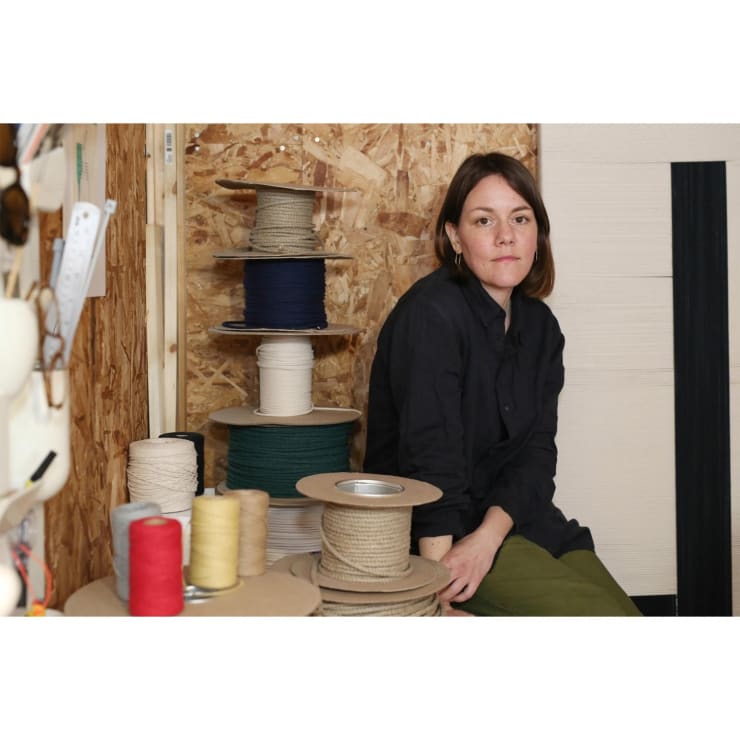Jo Elbourne creates taut and layered textile works, preoccupied with the seemingly endless potential of her practice, despite its limited parameters. It is a pared-down process with a simple yet exacting technique, rooted in the act of repetition, guided by an intuitive approach to proportion and a deeply felt relationship to colour.
Her compositions create a sense of space and equilibrium holding ideas around continuity, flow, rhythm and redirection through considered asymmetric arrangements.
A singular material - braided cotton - is used both in its raw state and as a carrier of colour. Cumulatively these rows of cord form a series of pathways and intersecting moments into abstract narratives.
Jo attended Wimbledon School of Art at foundation level and went on to earn a BA from Ravensbourne College of Design before a career designing clothes.
Jo is based in the coastal town of Margate in southeast England.
We sat down with Elbourne to discuss her artistic journey, inspirations, and process.
OTOMYS: Firstly, what led you towards a career as an artist?
Jo Elbourne: My design work gradually segued into art. I moved into a large shared multi-disciplinary studio space around the same time I’d started experimenting with textiles, but initially I hadn’t considered sharing the work or presenting it in the context of an artwork. I was still feeling governed by the need for my work to have a functional purpose. The studios became an encouraging container. That environmental shift along with the opportunity to participate in group shows and being around working artists really fostered a sense of creative possibility.
OTOMYS: How has your background in design informed your art practice? What techniques and methodologies have you carried over to your practice as a visual artist?
Jo Elbourne: My training and most of my previous career was spent as a clothing designer with just a short interlude designing furniture. In terms of methodologies, the way I understand proportion and colour has carried over. I would say that these are intrinsic skills as well, but being able to use them throughout my working life means I’ve had the chance to hone in on the nuances and I probably work with greater confidence because of that.
OTOMYS: Your exclusive use of braided cotton creates an incredibly tactile and rhythmic composition. What led you to working with this material, and what conceptual significance does it hold?
Jo Elbourne: The braid is made from the same raw material as an unprimed canvas, which is also the same raw material from which calico is made. This is the cotton cloth most commonly used to make a toile (the early sample version of a garment), so this echoes back to my college days learning about pattern-cutting and garment construction. That is to say it’s familiar to me, albeit in a new form. There was something immediately satisfying about working with the weight and fluidity of the cord which is both soft and strong. I like the element of transformation in creating a taut and structured surface from a pliable material. The fact that cotton takes dye very well is also important.
OTOMYS: What are the narratives that you explore within your works? How do you use abstraction to communicate these narratives?
Jo Elbourne: There are narratives in as much as the rows of cord effectively make a journey around the frame, and there are moments of overlap and interruption and redirection. There are sometimes large sections of colour which, intentionally, are barely seen, or only visible from a certain vantage point. I am interested in these moments in our lives and how the cumulative effects of single events can alter the course and the outcome of the whole. To me these feel like pathways and routes which are passing each other rather than static blocks of colour. There is an order and simplicity and flow in both the process and the finished work which for me creates a sense of presence, and this is something I would like to invite the viewer to access.
OTOMYS: Margate has been host to a variety of influential British artists over the years, with artists such as J.M.W Turner and Tracey Emin calling the coastal town home. Is there an artist’s community in your hometown today? Has Margate’s cultural history influenced your practice in any way?
Jo Elbourne: Yes definitely, in proportion to the size of the town, it feels as if there’s an abundance of artists. My practice has been influenced by being on the coast in that it’s liberating and expansive to be able to walk a few minutes from the studio to the beach and take in the distant horizon.
OTOMYS: Within your works, rows of cord and colour intersect in specific ways, with each composition depicting a unique arrangement. What is the symbolic significance of these asymmetrical compositions, and how do varying arrangements of cord and colour change the meaning of each work?
Jo Elbourne: I’ll often have a composition in mind as a point of departure, but I’ll assemble colours based on a feeling, and I try not to let my analytical mind jump in too early and make meaning. Increasingly I’m working on allowing space for my intuition to be front and centre.
That said, I am interested in moments where literal and figurative ideas overlap. For example, the concept of managing tension can be applied in several ways: it’s a practical/technical part of the physical making process but it also refers to the way that one’s nervous system can be regulated through the act of making. In terms of colour, the tension lies in introducing a discordant hue to an overly harmonious palette or achieving equilibrium through seemingly imbalanced asymmetry and proportion.
October 5, 2022

